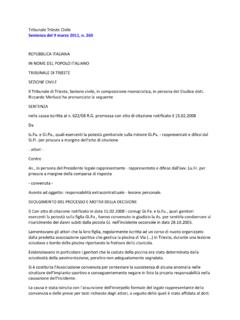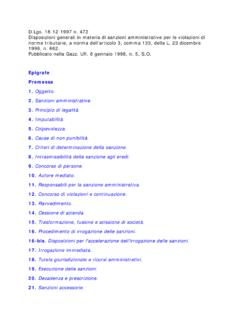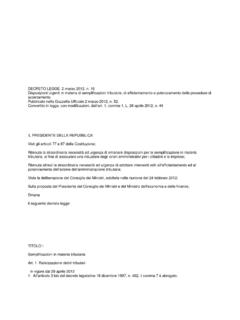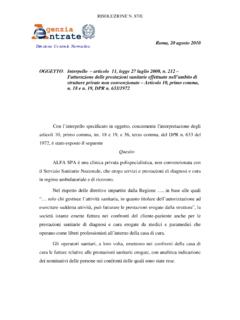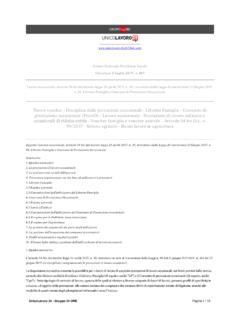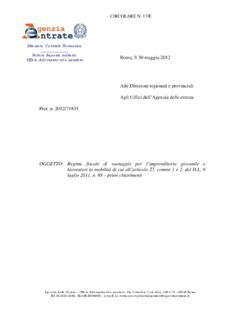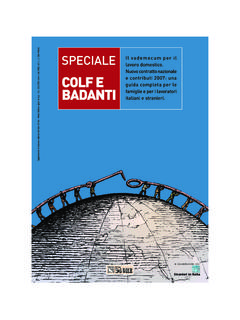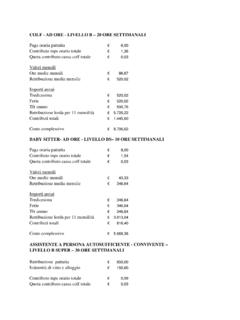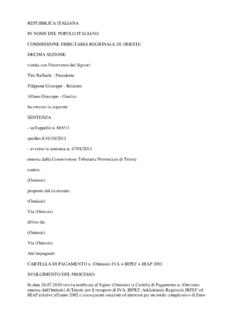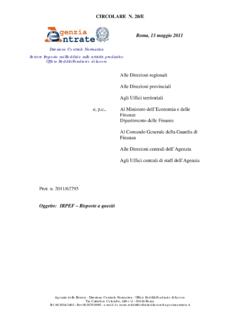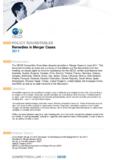Transcription of OECD Transfer Pricing Guidelines for Multinational ...
1 ISBN 978-92-64-09033-0 23 2010 09 1 Pw w w. o e c d . o rgJuly 2010 OECD Transfer Pricing Guidelines for Multinational Enterprises and Tax Administrations-:HSTCQE=U^UXXU:OECD Transfer Pricing Guidelines for Multinational Enterprises and Tax AdministrationsThe OECD Transfer Pricing Guidelines for Multinational Enterprises and Tax Administrations provide guidance on the application of the arm s length principle , which is the international consensus on Transfer Pricing , on the valuation, for tax purposes, of cross-border transactions between associated enterprises. In a global economy where Multinational enterprises (MNEs) play a prominent role, Transfer Pricing is high on the agenda of tax administrators and taxpayers alike. Governments need to ensure that the taxable profits of MNEs are not artificially shifted out of their jurisdictions and that the tax base reported by MNEs in their respective countries reflects the economic activity undertaken therein.
2 For taxpayers, it is essential to limit the risks of economic double taxation that may result from a dispute between two countries on the determination of an arm s length remuneration for their cross-border transactions with associated enterprises. The OECD Transfer Pricing Guidelines were approved by the OECD Council in their original version in 1995. A limited update was made in 2009, primarily to reflect the adoption, in the 2008 update of the Model Tax Convention, of a new paragraph 5 of Article 25 dealing with arbitration, and of changes to the Commentary on Article 25 on mutual agreement procedures to resolve cross-border tax disputes. In the 2010 edition, Chapters I-III were substantially revised, with new guidance on the selection of the most appropriate Transfer Pricing method to the circumstances of the case, the practical application of transactional profit methods (transactional net margin method and profit split method) and the performance of comparability analyses.
3 Furthermore, a new Chapter IX, on the Transfer Pricing aspects of business restructurings, was added. Consistency changes were made to the rest of the OECD Transfer Pricing OECD Transfer Pricing Guidelines for Multinational Enterprises and Tax AdministrationsJULY 2010 AnOECDB rowse_itEditionLectureseuleylnO daeRAbout OECD Browse_it editions In a traditional bookshop you can browse the display copies from cover-to-cover, free of charge. Wouldn t it be good to be able to do the same online? Now you can. OECD s Browse_it editions allow you to browse our books, online, from cover-to-cover. But, just as in a real bookshop where you can t take or copy pages from the books on display, we ve disabled the print and copy functions in our Browse-it editions - they re read-only. And, just as in a real bookshop, you may choose to buy or borrow from a library some titles you ve browsed, so we hope you ll buy or borrow our books when they meet your needs. Tell us what you think about our Browse-it service, write to us at OECD Publications You can purchase OECD books and e-books from our Online Bookshop - where, if you purchase printed editions you can download the e-book edition free of charge.
4 Our books are also available from a network of distributors, click the Distributors button on this website: to fi nd your nearest OECD publications Publications in Libraries You ll fi nd OECD publications in many institutional libraries around the world, especially at universities and in government libraries. Many subscribe to the OECD s own e-library, SourceOECD. SourceOECD provides online acess to our books, periodicals and statistical databases. If your institutional library does not yet subscribe to SourceOECD, tell your librarian about our free three-month trial offer. For more details about SourceOECD visit or email for a list. OECD Transfer Pricing Guidelines for Multinational Enterprises andTax Administrations22 JULY 2010 AnOECDB rowse_itEditionLectureseuleylnO daeRORGANISATION FOR ECONOMIC CO-OPERATION AND DEVELOPMENTThe OECD is a unique forum where governments work together to address the economic,social and environmental challenges of globalisation.
5 The OECD is also at the forefront of effortsto understand and to help governments respond to new developments and concerns, such ascorporate governance, the information economy and the challenges of an ageing Organisation provides a setting where governments can compare policy experiences, seekanswers to common problems, identify good practice and work to co-ordinate domestic andinternational OECD member countries are: Australia, Austria, Belgium, Canada, Chile, theCzech Republic, Denmark, Finland, France, Germany, Greece, Hungary, Iceland, Ireland, Italy,Japan, Korea, Luxembourg, Mexico, the Netherlands, New Zealand, Norway, Poland, Portugal, theSlovak Republic, Slovenia, Spain, Sweden, Switzerland, Turkey, the United Kingdom and theUnited States. The Commission of the European Communities takes part in the work of the Publishing disseminates widely the results of the Organisation s statistics gatheringand research on economic, social and environmental issues, as well as the conventions, Guidelines and standards agreed by its 978-92-64-09033-0 (print)ISBN 978-92-64-09018-7 (PDF)Also available in French: Principes de l'OCDE applicables en mati re de prix de transfert l'intention des entreprisesmultinationales et des administrations fiscalesCorrigenda to OECD publications may be found on line at: OECD 2010 You can copy, download or print OECD content for your own use, and you can include excerpts from OECD publications,databases and multimedia products in your own documents, presentations, blogs, websites and teaching materials, providedthat suitable acknowledgment of OECD as source and copyright owner is given.
6 All requests for public or commercial use andtranslation rights should be submitted to Requests for permission to photocopy portions of this material forpublic or commercial use shall be addressed directly to the Copyright Clearance Center (CCC) at ais d exploitation du droit de copie (CFC) at daeRFOREWORD 3 OECD Transfer Pricing Guidelines OECD 2010 ForewordThese Guidelines are a revision of the OECD Report Transfer Pricing and Multinational Enterprises (1979). They were approved in their original version by the Committee on Fiscal Affairs on 27 June 1995 and by the OECD Council for publication on 13 July 1995. Since their original version, these Guidelines have been supplemented: By the report on intangible property and services, adopted by the Committee on Fiscal Affairs on 23 January 1996 [DAFFE/CFA(96)2] and noted by the Council on 11 April 1996 [C(96)46], incorporated in Chapters VI and VII; By the report on cost contribution arrangements, adopted by the Committee on Fiscal Affairs on 25 June 1997 [DAFFE/CFA(97)27] and noted by the Council on 24 July 1997 [C(97)144], incorporated in Chapter VIII; By the report on the Guidelines for monitoring procedures on the OECD Transfer Pricing Guidelines and the involvement of the business community [DAFFE/CFA/WD(97)11/REV1], adopted by the Committee on Fiscal Affairs on 24 June 1997 and noted by the Council on 23 October 1997 [C(97)196], incorporated in the annexes.
7 By the report on the Guidelines for conducting advance Pricing arrangements under the mutual agreement procedure, adopted by the Committee on Fiscal Affairs on 30 June 1999 [DAFFE/CFA(99)31] and noted by the Council on 28 October 1999 [C(99)138], incorporated in the annexes; By the report on the Transfer Pricing aspects of business restructurings, adopted by the Committee on Fiscal Affairs on 22 June 2010 [CTPA/CFA(2010)46] and approved by the Council on 22 July 2010 [Annex I to C(2010)99], incorporated in Chapter IX. AnOECDB rowse_itEditionLectureseuleylnO daeR4 FOREWORD OECD Transfer Pricing Guidelines OECD 2010 In addition, these Guidelines have been modified: By an update of Chapter IV, adopted by the Committee on Fiscal Affairs on 6 June 2008 [CTPA/CFA(2008)30/REV1] and an update of the Foreword and of the Preface, adopted by the Committee on Fiscal Affairs on 22 June 2009 [CTPA/CFA(2009)51/REV1], approved by the Council on 16 July 2009 [C(2009)88]; By a revision of Chapters I-III, adopted by the Committee on Fiscal Affairs on 22 June 2010 [CTPA/CFA(2010)55] and approved by the Council on 22 July 2010 [Annex I to C(2010)99]; and By an update of the Foreword, of the Preface, of the Glossary, of Chapters IV-VIII and of the annexes, adopted by the Committee on Fiscal Affairs on 22 June 2010 [CTPA/CFA(2010)47] and approved by the Council on 22 July 2010 [Annex I to C(2010)99].
8 These Guidelines will continue to be supplemented with additional guidance addressing other aspects of Transfer Pricing and will be periodically reviewed and revised on an ongoing basis. AnOECDB rowse_itEditionLectureseuleylnO daeRTABLE OF CONTENTS 5 OECD Transfer Pricing Guidelines OECD 2010 Table of Contents Preface .. 17 Glossary .. 23 Chapter IThe Arm's Length .. of the arm s length principle .. 9 of the OECD Model Tax Convention .. the arm s length principle as the internationalconsensus .. non-arm s-length approach: global formulary apportionment .. and description of approach .. with the arm's length principle .. of non-arm's-length for applying the arm s length analysis .. of the comparability analysis and meaning of comparable .. determining comparability .. Characteristics of property or services .. analysis .. terms .. circumstances .. strategies.
9 Of the actual transactions undertaken .. effect of government policies .. of customs valuations .. 56 AnOECDB rowse_itEditionLectureseuleylnO daeR6 TABLE OF CONTENTS OECD Transfer Pricing Guidelines OECD 2010 Chapter IITransfer Pricing MethodsPart I: Selection of the Transfer Pricing method .. of the most appropriate Transfer Pricing method to thecircumstances of the case .. of more than one method .. 62 Part II: Traditional transaction methods .. uncontrolled price method .. of the application of the CUP method .. price method .. of the application of the resale price method .. plus method .. of the application of the cost plus method .. 75 Part III: Transactional profit methods .. net margin method .. and weaknesses .. for application .. comparability standard to be applied to the transactionalnet margin method .. of the net profit indicator .. of the net the net profit .. where the net profit is weighted to sales.
10 Where the net profit is weighted to costs .. where the net profit is weighted to assets .. possible net profit indicators .. 90 AnOECDB rowse_itEditionLectureseuleylnO daeRTABLE OF CONTENTS 7 OECD Transfer Pricing Guidelines OECD 2010 ratios .. guidance .. of the application of the transactional netmargin method .. profit split method .. and weaknesses .. for application .. general .. approaches for splitting the profits .. analysis .. analyses .. the combined profits to be split .. or projected profits .. measures of profits .. to split the combined profits .. general .. on data from comparable uncontrolledtransactions .. keys .. on data from the taxpayer s own operations ( internal data ) .. on transactional profit methods .. 105 Chapter IIIC omparability a comparability process .. analysis of the taxpayer s circumstances .. of the controlled transaction and choice of thetested party.
